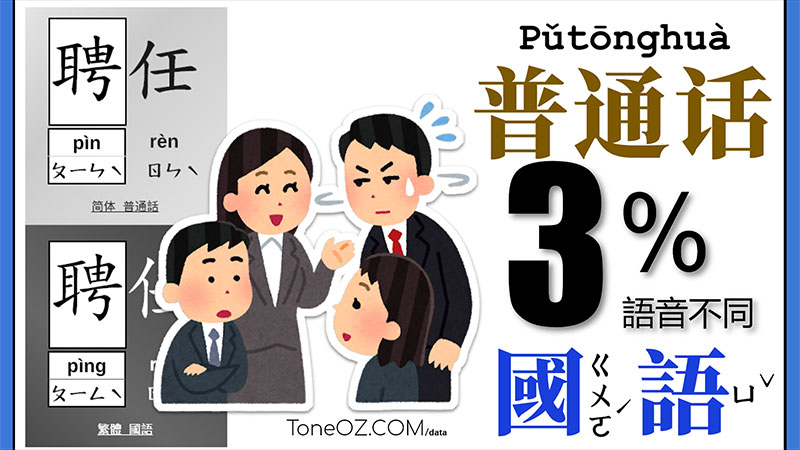Given 100 questions, a Pinyin student answered all correctly, but a Zhuyin teacher might only give him a score 97% . Why ?
Mainland Common Tongue (Pǔtōnghuà 普通話) and Taiwan National Language (Guóyǔ 國語)
By “character” : 13~38% Diff
There were many essays related to the topic “Pronunciation differences in Chinese Mandarin between Mainland and Taiwan”. e.g. :
“Comparison of the Chinese pronunciations between Mainland China and Taiwan” (海峽兩岸字音比較) by Qingmei Li (李青梅), 1992
“A Study of the Distinction of Pronunciation Standards between Taiwan and Mainland China” (兩岸語音規範標準之差異探悉) by Jihong Nan (南基弘), 2008
Most of them are based on “Diff by character” : The 3500 high frequency words specified in “List of Commonly Used Characters in Modern Chinese” (現代漢語通用字表, 1988).
Experts check the differences character by character. While a mismatched pronunciation was found, essays usually provide several example “words / vocabularies” with that character.
E.g.: 绩/績 (means “achievement”) is pronounced differently. In Mainland it is tone 4 (jì ㄐㄧ\), while in Taiwan it is tone 1 (jī ㄐㄧ). As an example, the vocabulary “成绩/成績” :
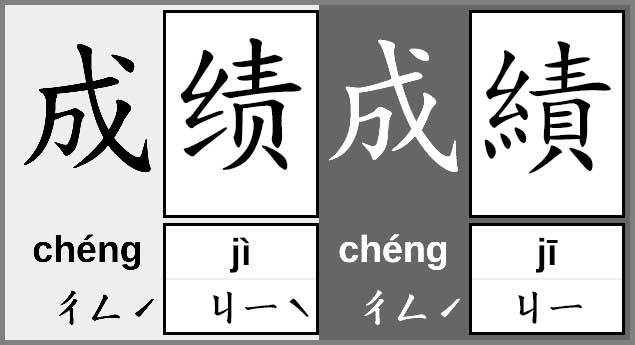
In this way, a final diff percentage was calculated, based on characters:
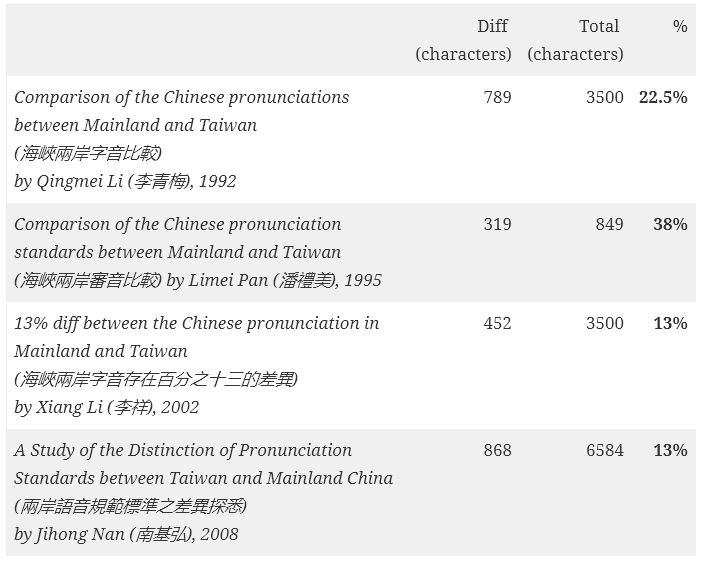
“13%~38%” is a large difference. It makes people feel like a student could only get a reduced score of 62%, with his 100% corret study from the other side? A little bit more than realistic.
By “vocabularies” : 3% Diff
In stead of only compare the 3500 characters, ToneOZ tried a new way : To compare all 170,000+ words / vocabularies in the dictionary. The Chinese characters are pronounced differently after they are combined into words / vocabularies, this should give us some data from a different point of view.
By “vocabularies”, there are 513 characters from around 6K words/vocabularies have been identified with different pronunciation between the Common Tongue and the National Language. It is based on a programmatically comparison and then a manual review for around 170K words/vocabularies from several word banks :
CEDICT (the largest open source Mandarin-English Dictionary)
National Language Mandarin official dictionaries “Applied Modern version Jian-Bian-Ben” (國語辭典簡編本) and “Literature version Zhong-Bian-Ben” (國語辭典重編本) by the Taiwan Ministry of Education)
“Jeiba” Chinese text segmentation database.
The diff rate is 3.88% : In all 170,580 words, there are 6,623 words are pronounced differently.
We also use word banks to filter percentages from “high frequency words” only. In Australia, there are 2 common Chinese certifications:
Chinese Proficiency Test, Hanyu Shuiping Kaoshi
(漢語水平考試 , HSK)
Test of Chinese as a Foreign Language
(華語文能力測驗, TOCFL)
They are both designed for non native Chinese speakers to learn general conversations. As results:
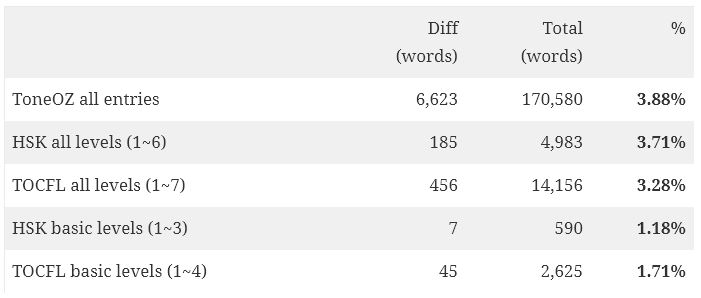
The results filtered by HSK and TOCFL are all close to 3%, which gives us more confidence in this number. And if we filter from basic levels only, the percentage becomes around 1%(For basic conversation ability, HSK level 3 or TOCFL level 4 is required).
In conclusion : There are pronunciation differences in Chinese Mandarin between Mainland and Taiwan, but not too much, only about 3% words are pronounced differently. In general conversation the difference rate could become 1% only. You don’t have to worry too much about these differences if you are learning Chinese.
Toneoz.com/data provides a list for all the Chinese words with pronunciation differences, and it can also check pronunciation differences from a whole Chinese sentence.
Read More
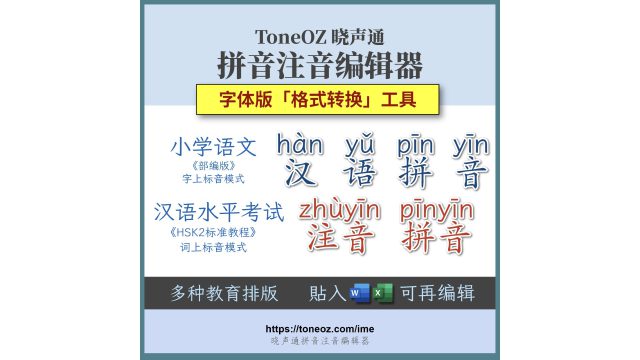
正词双拼、汉语拼音加汉字,Word文字排版可编辑
用ToneOZ的「格式转换」功能即可在Office Word中打出注音拼音双拼、或汉语拼音加汉字。可选择词标音或字标音,支援《正词法》及《人教版语文》等多种排版方式。贴入Word后,文字可再编辑。 字体版编辑器网址 https://toneoz.com/ime 使用方法 在晓声通ToneOZ字体版打字。请选「仅汉字」系列字体。下方「格式转换」工具,选:「a. 字pīn」及「1. 词上标音」或「2.词下标音」按下方「汇出格式转换」按钮。ToneOZ会显示「已汇出剪贴板!请贴到其他App」打开Office Word,贴上即可。请记得先到「字型下载区」找到适当字体安装 如何调整排版 …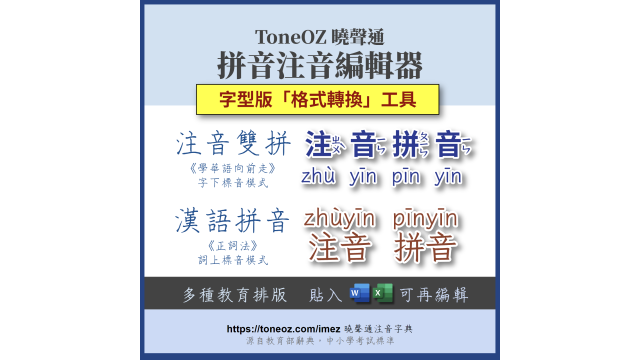
注音雙拼、漢語拼音加漢字,Word文字排版可編輯
可編輯式拼音編輯功能「格式轉換」 用ToneOZ的「格式轉換」功能即可在Office Word中打出注音拼音雙拼、或漢語拼音加漢字。可選擇詞標音或字標音,支援《正詞法》及《學華語向前走》等多種排版方式。貼入Word後,文字可再編輯。 「雙拼」「注音」「拼音」多音字型 曉聲通也提供免費的TTF多音字型下載,請參考「多音字型下載」區 多音字編輯器網址 https://toneoz.com/imez 使用方法 在曉聲通ToneOZ字型版打字。 注音雙拼時,請選「ㄅ」注音系列字型。即注音符號在右邊的字型,再搭配本頁介紹的格式轉換便可以把漢語拼音加在上面 …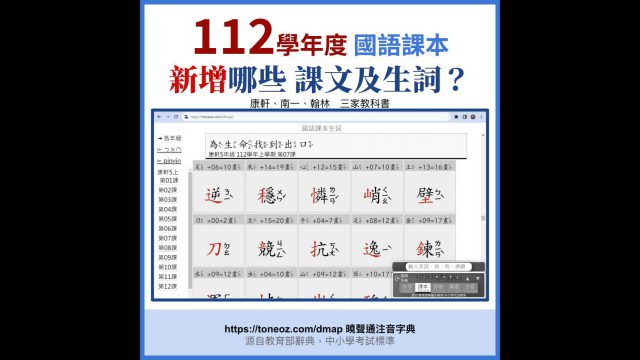
112學年度國語課本,有哪些新增修訂?
112學年度新學期、新課本、新課文、重點更新有哪些?三家出版商準備了許多新課文與新生字詞,習題及考試題目當然也都搭配好了。新課文最多的是108課綱應屆五年級同學,其他各年級也多少有修改。 以下列表把各出版商的修改處都分類整理好了,方便老師們備課。如需搭配免費的字典工具,請到搜尋引擎找關鍵字「曉聲通注音字典」即可,所有新課文生字詞都已更新。 曉聲通注音字典能以注音字型顯示教育部辭典全文內容,並且支援「詞語廣度擴展」,點擊辭典內文中不熟悉的詞,瞬間連續查詢帶出更詳細的詞與解釋。 ++++ 翰林112上學期 ++++ == 翰林3上 == 變動課文 …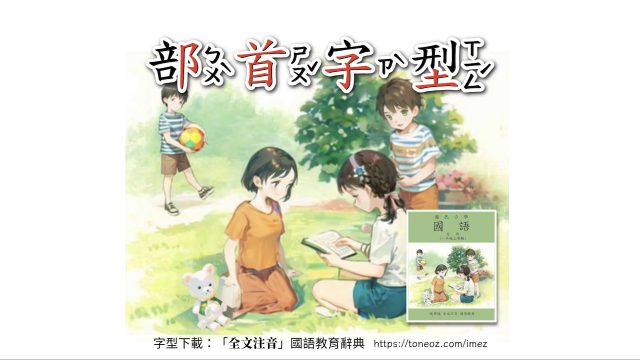
中文如何做出「部首變色」效果?使用免費的課本生詞「曉聲通部首字型」。
國語課本的生字詞普遍使用「部首變色」的特殊字型,來幫助學生了解生字的部首及部件位置。透過視覺上的強調,在自然而然的閱讀中熟悉漢字的結構和規則,提高認字閱讀能力。 使用免費的「澳聲通部首字型」便可輕鬆做出「部首變色」的字型效果。(字型下載請到https://toneoz.com/blog/download-fonts/) 這是「曉聲通 全文注音 國語辭典」提供的免費字型,經過特殊編輯,只會顯示符合教育部標準的部首部件(即「康熙字典214部首」),目前支援六千多字,涵蓋教育部簡編本國語詞典,及台灣三家出版社歷年國語課本生詞。支援注音與拼音,分別與澳聲通注音及拼音繁體字型相對應,同樣提供免費商用授權,老師們可任意使用不用額外付費。 使用的方法是:在Office文件中複製兩個內容一模一樣的文字方塊,位置完全重疊。下方的文字方塊使用「澳聲通庫楷」楷體字型,上方的文字方塊用部首字型並設定成紅色。如此便可產生出「只有部首變色」的字體。 澳聲通全系列字型都支援多音字,注音拼音兩種版本任選。利用線上選音器 https://toneoz.com/imez 可以自動或手動選破音多音字,也可將整編文章的注音關閉(全選文章後,切換上方工具列的「注音/拼音」開關即可)。注音資訊會內嵌在文字中,可直接複製到Office中使用,選好的多音破音會一起跟著複製。 請至「曉聲通字型專頁」下載免費字型檔案 …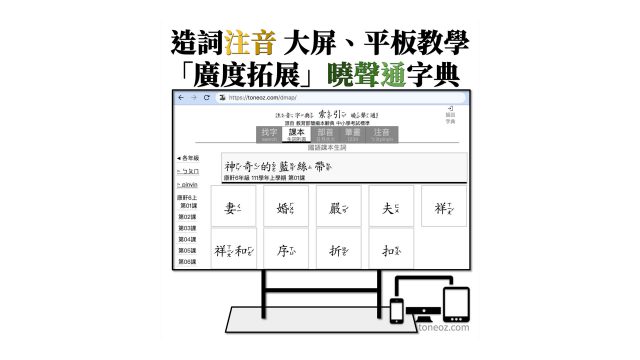
教育注音字典「曉聲通」- 為大屏、平板教學設計的「廣度拓展」國語辭典
曉聲通字典源自教育部《一字多音審定表》標準辭典,使用中小學考試標準字音及字詞解釋。網址:https://toneoz.com/dmap 介紹一些容易上手又好玩的國語字典功能,如「掃描成語造詞」「同部首字探索」「課本生詞連動」…透過特別設計的使用介面,讓老師們在大屏跟平板教學時有效果又有效率。 Web4.0智慧物聯網時代的字典 Web 4.0智慧物聯網時代,如果只是為了查一個字或查一個詞的解釋,大部分人會找搜尋引擎或直接問手機的語音助理。字不會寫可以直接語音輸入,字不會唸可以手寫輸入,萬一不會唸也不會寫,還可以直接拍照影像搜尋。 然而一本好的字典,在教育場合有個靈魂功能:「拓展詞彙」。 詞彙的「廣度拓展」:無法取代的查字典樂趣 舉例來說: 語言素養的形成,除了「直向」查詢字義的深度探索,也需要字詞間「橫向」連結的廣度拓展。透過查字典的過程來發現更多字詞左右鄰居之間的關聯,再連結到生活中的經驗,這樣的樂趣能提供動機,激發主動學習的興趣。傳統紙本字典在翻找的時候,讀者自然而然會接觸到許多前一頁後一頁上額外的字彙,這些都是查詢生字時的無形收穫。 曉聲通字典:教育部標準資料、瞬間呈現橫向關聯、支援多音注音字型 …
